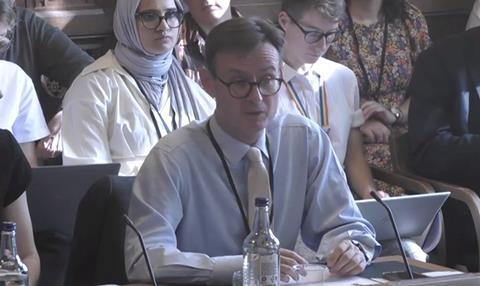But top boss admits it is having to compete with schools for specialist inspectors
The NHS expects to finish scouring its estate for reinforced autoclaved aerated concrete (RAAC) in the next few weeks but is facing competition for surveyors from the education sector, one of its top bosses has said.
Speaking to the public accounts committee last week, NHS England’s deputy chief Julian Kelly set out the body’s approach to RAAC and its knock-on effects on the New Hospitals Programme.

NHS England has been surveying and undertaking RAAC mitigation work since 2019 and Kelly, who is also the organisation’s chief financial officer, explained that it had a full understanding of issues and mitigation and eradication plans in place for 24 schemes.
Mitigation plans are in place and eradication plans are in development for six additional sites where RAAC was identified over the past year.
The health authority, which has a commitment to eradicate RAAC by 2035, recently went back to all NHS trusts following an update to guidance from the Institute of Structural Engineers, asking them to confirm again that they were confident of the absence of RAAC.
According to Kelly, “a number of trusts” came forward saying they may have RAAC planks in their hospitals. Asked how many by committee chair Meg Hillier, he confirmed that the number was in the tens, not hundreds, of hospitals.
A National Audit Office (NAO) report published in July had identified 41 buildings at 23 hospital sites as containing RAAC.
What is RAAC exactly?
Reinforced autoclaved aerated concrete (RAAC) is a cementitious material made from fine aggregates. Produced as precast planks, RAAC was used extensively between the 1950s and early 1990s, mainly for flat roof structures. But the nature of the material means that it has a limited life of 30 years with structural deficiencies becoming apparent in the 1990’s. In 2018 a school flat roof built from RAAC catastrophically collapsed at a weekend, prompting the Local Government Association and Department for Education to contact all school building owners to warn them about the material.
>> Proportion of RAAC likely to be higher among schools yet to return DfE questionnaires
“In many cases this is this is quite small – it could even be an unused boiler house; it could be a couple of wall panels in one office,” said Kelly, adding that full surveys should be completed “in a matter of weeks”.
The committee raised concerns about the supply of surveyors, given the high demand within the education sector.
Asked by Hillier if they were “fishing in the same pool” as education providers, he said they would “undoubtedly” be using the same firms.
“There is a limited number of these specialist engineers, so we will all be talking to the same firms – that has to be true,” he admitted.
According to a statement on the Department of Health and Social Care’s website, the NHS’ RAAC mitigation programme is backed with additional funding of £689m from 2021 to 2025.
On top of this, the government has announced that the seven NHS hospitals most affected by the problem concrete will be replaced by 2030 through the New Hospital Programme.
>> Construction yet to start on all but seven of government’s 40 new hospitals
>> Rebooting the New Hospital Programme: Is this the solution to the NHS backlog?
Hillier told NHS procurement bosses that it seemed to her that the numbers did “not stack up” in terms of spending and delivery timeframes for the programme.
The project was costed on the basis that contractors using modern methods of construction could build 25% cheaper and 20% quicker than on previous hospital jobs but final standardised designs for the so-called hospital 2.0 will not be ready until next May.
The NAO’s July report said the government was likely to miss its 2019 election pledge to build 40 new hospitals by 2030.
It found that the New Hospital programme was behind schedule and that just 32 were likely to complete by the end of the decade.



























No comments yet